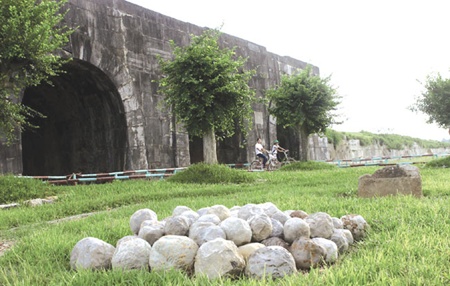People residing in the vicinity of the Citadel of the Ho dynasty in Thanh Hoa Province will be given cameras and taught photographic and filmmaking skills to create their own images depicting life around the World Heritage site.
 |
| Historic: A corner of the Ho Dynasty Citadel recognised as a World Cultural Heritage site in 2011. A project has been launched to help nearby residents photograph and preserve the site. — Photo thethaovanhoa.vn |
The project, Building and Displaying in the Vicinity of the Ho Dynasty Citadel using Photovoice Methods, runs from June through the end of December. Using Photovoice, a technique of telling stories by displaying images, the project is also meant to raise the awareness of local people and encourage them to take an active part in preserving the country's cultural heritage.
Initially, eight households in Vinh Tien and Vinh Long communes in Vinh Loc District will benefit from the project, which is part of a large-scale project to revitalise World Heritage site museums in Cambodia, Laos and Vietnam, jointly operated by UNESCO and the Japan Funds-in-Trust.
According to an official from UNESCO Vietnam, the project, undertaken for the first time, seeks to study and learn about stories, thoughts and the hopes of local communities in relation to the conservation and preservation of heritage sites.
"The stories are expected to showcase their love of heritage, challenges, as well as opportunities in protecting and bringing into full play cultural heritage values of the Ho Dynasty Citadel," said Nguyen Duc Tang of the Hanoi-based office of the UN cultural agency.
"This will help heritage managers better understand and incorporate with local residents, thus, constructing short-and long-term strategies to call for and enhance their responsibility towards these works."
Tang noted that the citadel is among a few heritage sites located within a living community. This is one of the important factors for shaping development and conservation models involving the community.
The Ho Dynasty Citadel was Vietnam's capital under the Ho dynasty (1398-1407). Located in Vinh Loc District, the citadel measures 870m by 883m and was built in 1397. It is the only citadel in the country built entirely of stone and remained nearly intact throughout the nation's often turbulent history.
It was recognised as a World Cultural Heritage Site by UNESCO on June 27, 2011. According to experts the structure represents an outstanding example of a new style of construction for a Southeast Asian imperial city.
"Since it received the honour, the site has witnessed a considerable increase of visitors," said Tang. "And the citadel's Heritage Preservation Centre has developed numerous plans and strategies to effectively uphold its cultural, architectural and historical values."
However, a recent report revealed that local authorities and the site managers are facing several difficulties in the preservation process.
While the Law on Cultural Heritage and the site's management regulations stipulate that the core area must be strictly protected, some houses in the area have built, and even upgraded their homes.
"Cultivation within the protected area has affected underground architecture at the site. We've reported the situation to authorities several times, but the situation has yet to improve," the vice director of the citadel's Heritage Preservation Centre, Nguyen Xuan Toan, said.
"Giving cameras to the local people and letting them tell stories through images and cultural subjects will enable those living within the heritage site to express their emotions and feelings in their own way," said Toan.
"They are merely farmers who get used to fields and have never touched a camera. But they all adore and feel proud of the heritage and abroad. Such a love will help them to produce the most realistic photos and videos."
No comments:
Post a Comment